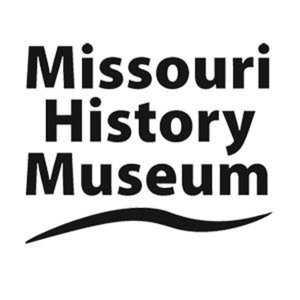from Apr. 15, 1865
"President Lincoln Dead"
-
Full Title
"President Lincoln Dead. Assassinated in the Theatre at Washington Last Night"
-
Description
The Daily Dispatch, from Erie, PA, announces the death of President Lincoln and provides many details of the attack at Ford's Theatre, as well as the other attack on Secretary of State William Seward.
-
Source
Library of Congress Alfred Whital Stern Collection of Lincolniana portfolio 16, no. 27
-
Rights
This item is in the public domain and may be reproduced and used for any purpose, including research, teaching, private study, publication, broadcast or commercial use, with proper citation and attribution
-
Tags
-
Cite this Item
Daily Dispatch. ""President Lincoln Dead. Assassinated in the Theatre at Washington Last Night"". Remembering Lincoln. Web. Accessed June 23, 2025. https://rememberinglincoln.fords.org/node/738
-
Creator
Daily Dispatch
-
Date
April 15, 1865
from Apr. 15, 1865
"President Lincoln Dead. Assassinated in the Theatre at Washington Last Night"
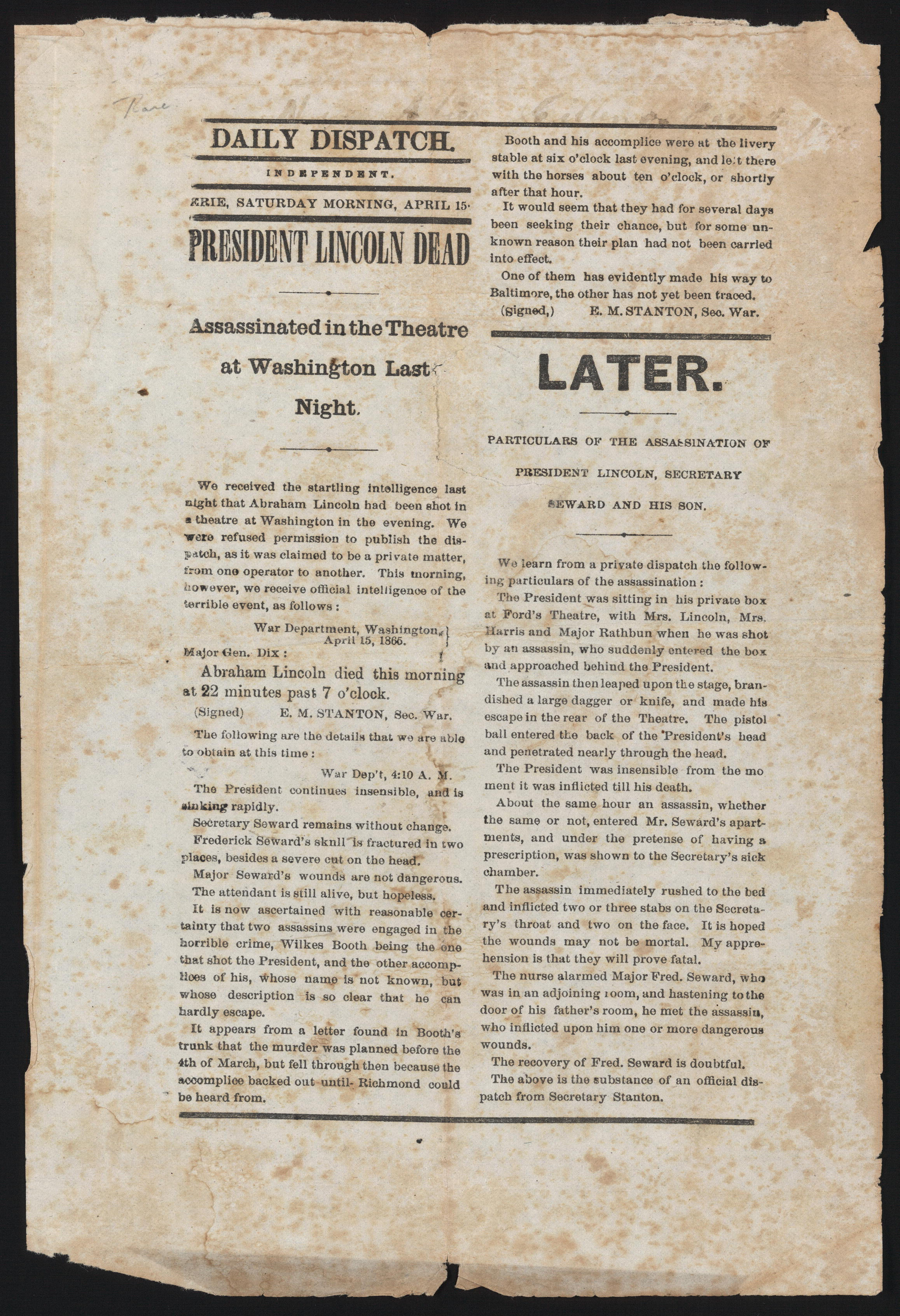
-
Description
The Daily Dispatch, from Erie, PA, announces the death of President Lincoln and provides many details of the attack at Ford's Theatre, as well as the other attack on Secretary of State William Seward.
-
Source
Library of Congress Alfred Whital Stern Collection of Lincolniana portfolio 16, no. 27
-
Rights
This item is in the public domain and may be reproduced and used for any purpose, including research, teaching, private study, publication, broadcast or commercial use, with proper citation and attribution
-
Creator
Daily Dispatch
-
Date
April 15, 1865
from Apr. 17, 1865
Louisville Daily Union Press
-
Full Title
Louisville Daily Union Press
-
Description
A full page spread in the Louisville Daily Union Press detailing the assassination and the national feelings at the moment.
-
Source
Library of Congress Alfred Whital Stern Collection of Lincolniana
-
Rights
This item is in the public domain and may be reproduced and used for any purpose, including research, teaching, private study, publication, broadcast or commercial use, with proper citation and attribution
-
Tags
-
Cite this Item
Louisville Daily Union Press. "Louisville Daily Union Press". Remembering Lincoln. Web. Accessed June 23, 2025. https://rememberinglincoln.fords.org/node/734
-
Creator
Louisville Daily Union Press
-
Date
April 17, 1865
from Apr. 17, 1865
Louisville Daily Union Press
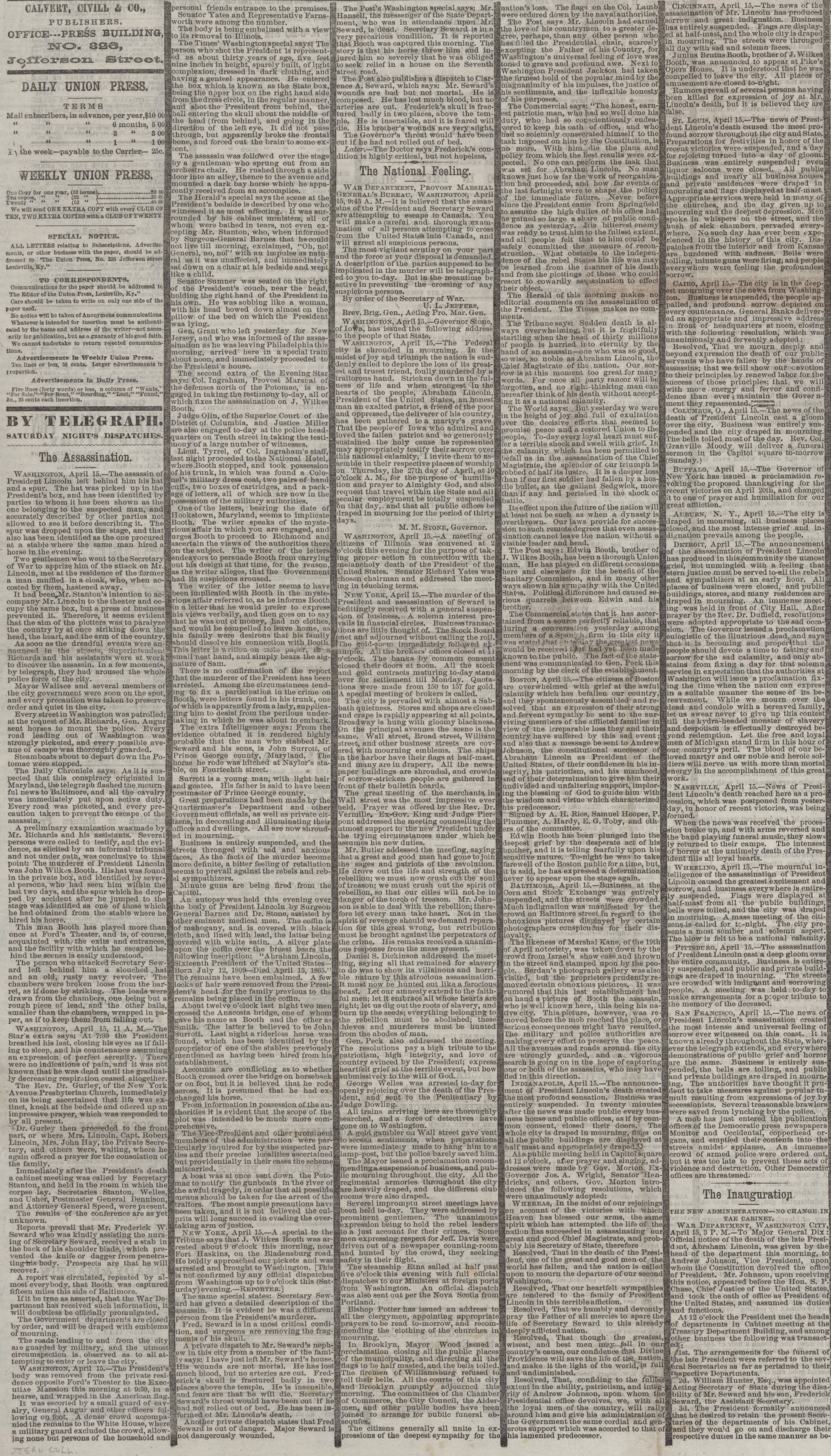
-
Description
A full page spread in the Louisville Daily Union Press detailing the assassination and the national feelings at the moment.
-
Source
Library of Congress Alfred Whital Stern Collection of Lincolniana
-
Rights
This item is in the public domain and may be reproduced and used for any purpose, including research, teaching, private study, publication, broadcast or commercial use, with proper citation and attribution
-
Creator
Louisville Daily Union Press
-
Date
April 17, 1865
from Mar. 23, 2015
The New York Herald, April 15, 1865
-
Full Title
The New York Herald, April 15, 1865
-
Description
On April 15, 1865, The New York Herald published seven editions about the assassination of President Abraham Lincoln, including this 10:00 a.m. edition. Details of the plot to assassinate the president emerged in this edition. Secretary of War Edwin Stanton reported the discovery of a letter in John Wilkes Booth’s room at the National Hotel containing details of the conspiracy and implicating accomplices. The borders of the 5th column have heavy black borders [known as mourning rules] to denote the tragic news of Lincoln's death.
-
Source
HN-1865-011077
-
Rights
Use of this item for research, teaching, and private study is permitted with proper citation and attribution as follows: Courtesy, Newseum Collection. Reproduction of this item for publication, broadcast, or commercial use requires written permission. For permission, please contact the Newseum.
-
Tags
-
Cite this Item
James Gordon Bennett. "The New York Herald, April 15, 1865". James Gordon Bennett. Remembering Lincoln. Web. Accessed June 23, 2025. https://rememberinglincoln.fords.org/node/697
from Mar. 23, 2015
The New York Herald, April 15, 1865
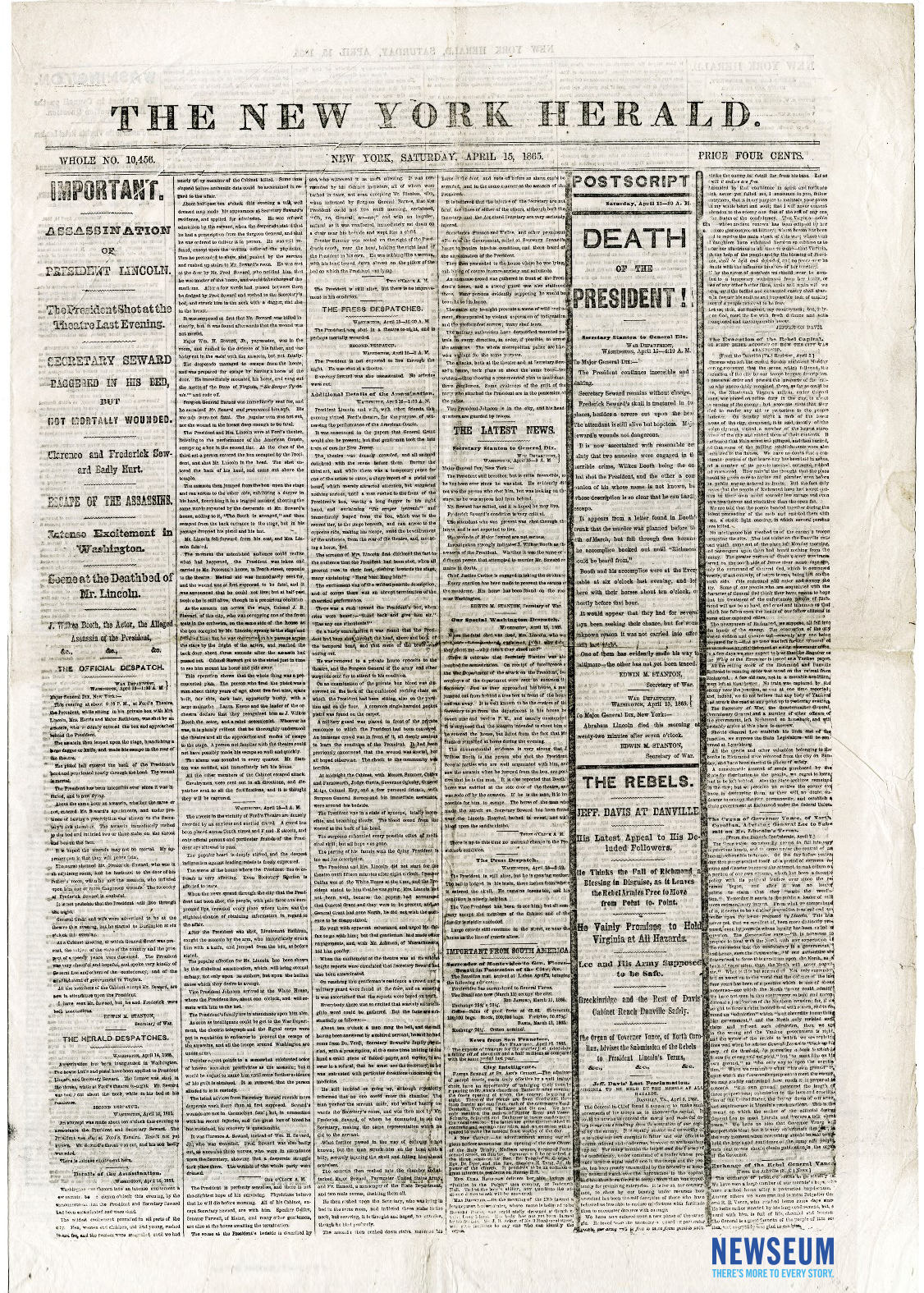
-
Description
On April 15, 1865, The New York Herald published seven editions about the assassination of President Abraham Lincoln, including this 10:00 a.m. edition. Details of the plot to assassinate the president emerged in this edition. Secretary of War Edwin Stanton reported the discovery of a letter in John Wilkes Booth’s room at the National Hotel containing details of the conspiracy and implicating accomplices. The borders of the 5th column have heavy black borders [known as mourning rules] to denote the tragic news of Lincoln's death.
-
Source
HN-1865-011077
-
Rights
Use of this item for research, teaching, and private study is permitted with proper citation and attribution as follows: Courtesy, Newseum Collection. Reproduction of this item for publication, broadcast, or commercial use requires written permission. For permission, please contact the Newseum.
-
Creator
James Gordon Bennett
-
Publisher
James Gordon Bennett
-
Date
March 23, 2015
from Apr. 30, 1865
Horatio Nelson Taft Diary, April 30, 1865
-
Full Title
Horatio Nelson Taft Diary, April 30, 1865
-
Description
Patent examiner Horatio Nelson Taft discussed the events of the previous month, calling April 1865 "the most eventful in the History of our Country."
-
Transcription
April 30th 1865
This has been a most eventful month. The most eventful in the History of our Country. We have seen during this month the complete crushing out of the “Great rebellion” by a series of masterly Military achievements. The occupation of the Rebel Capitol by our troops. The surrender of Genl Lee with his Army near Richmond, and the surrender of Genl Johnson and his Army in North Carolina, and above all in importance which has occured in the World during this month, The President of the United States has been assassinated. Abraham Lincoln, the good and kind hearted, was Shot while sitting in his Box at Fords Theatre on the night of the 14th Int at about half past ten O'clock. Mr Lincoln had been in the habit of attending the Theatre occasionaly, perhaps once in four or six weeks, as a relaxation from the arduous duties of his position and constant mental exertion. On this occasion he went rather reluctantly. But it had been published in the Bills that Himself and Genl Grant would be present, and Genl Grant having left the City in the evening train for Phila, the President said that he did not “wish the people to be disappointed” and so went with his Lady arriving about ½ past 8. Miss Harris (daughter of Hon Ira Harris) and Maj Rathbone of Albany were also in the same Box, which was a double one, two being thrown into one. This Box was in the 2nd Tier and entered from the Dress circle through a narrow corridor some three feet wide and eight or ten long. There was a door at the dress circle end and at the other end there were two doors, one for each Box but now the two Boxes being thrown into one, one of the doors was closed. The other was open, and all of them unguarded. The assassin J Wilkes Booth had made his arrangements in the most deliberate manner (probably during that day). He had fixed a bar across the door leading into the dress circle and had cut a hole through the closed door leading to the Box, which enabled him to see the exact position of the President and others in the Box without being seen himself. At about ½ past 10, he entered the corridor from the Dress circle, bared the door to prevent any one from entering, examined the position of Mr Lincoln through the hole in the closed door. Then entered the Box behind all who were there (as they were looking toward the stage) and standing within three or four feet of Mr Lincoln, Shot him in the back of the head. The ball entering about two inches from the left ear near the base of the skull and lodging in the brain about two inches back of the right eye. His head was probably inclined forward at the time. The Murderer rushed to the front of the Box with a dagger in his hand. Major Rathbone caught his coat but Booth struck him on the arm with the dagger wounding him severely, which compelled him to let go his hold. Booth vaulted over the front of the Box and as he did so exclaimed “Sic Semper Tyranis” (Thus To Tyrants). As he Jumped from the box his spur cau[gh]t in the flag and as he struck the to see the exact position of the President and others in the Box without being seen himself. At about ½ past 10, he entered the corridor from the Dress circle, bared the door to prevent any one from entering, examined the position of Mr Lincoln through the hole in the closed door. Then entered the Box behind all who were there (as they were looking toward the stage) and standing within three or four feet of Mr Lincoln, Shot him in the back of the head. The ball entering about two inches from the left ear near the base of the skull and lodging in the brain about two inches back of the right eye. His head was probably inclined forward at the time. The Murderer rushed to the front of the Box with a dagger in his hand. Major Rathbone caught his coat but Booth struck him on the arm with the dagger wounding him severely, which compelled him to let go his hold. Booth vaulted over the front of the Box and as he did so exclaimed “Sic Semper Tyranis” (Thus To Tyrants). As he Jumped from the box his spur cau[gh]t in the flag and as he struck the Stage he came to a crouching position from the effect of the concussion, his hands striking the floor but he recovered himself in a moment and flourishing his dagger he strode across the Stage some forty feet in sight of the spectators and past some of the actors, and reaching the back door which opens into a lane, he mounted a fleet horse and escaped. The lane enters F St betwen 9th & 10 Sts. The audience was paralized for some seconds, but rushed on to the Stage. A Surgeon was called for and Charles S Taft a Surgeon being present was lifted up from the Stage to the Box by those present. Before this the bar had been removed by Maj Rathbone and several men had reached the Box. When Chas reached the Box the President was lying upon the floor. Water and stimulants were used immediately but without avail in attempts to revive him. He was taken up and carried from the Theatre to the House opposite in
about fifteen minutes after he was shot. A Dr Leale from Armory Square Hospital was the first Surgeon in the box. But Chas did not know that there was any Surgeon but himself present until the President was removed from the Theatre. Chas had charge of him until Dr Stone (the Presidents family Physician) arrived which was half an hour after he was placed on a bed at the House of Mr Peterson, opposite. When the shot was fired Mrs Lincoln was sitting near her husband with her hand on his knee. She says she saw the flash and heard the report of the pistol, thinking it was in some way connected with the the Play. She leaned forward to see what it was, and then looked to Mr Lincoln to see where he was looking. He was sitting with his head droped down and eyes shut. She was not alarmed at this, he sometimes held his head in that way when in deep thought, but she put her hand on his forehead and he not stirring she put it on the back of his head and feeling it wet she immediately withdrew it covered with blood. She then screamed and that is the last she remembered that took place in the Theatre. She says, as she put her hand on his head she recollects that something suddenly brushed past her and rubbing off her Shawl. It was Booth as he jumped from the Box. The President made no noise, nor attempted to speak, nor Stirred a limb after he was shot, nor was he conscious for one moment from that time until he died. When his skin was touched or his hand was taken, there was a slight quiver or tremor of the muscles, but that was all. Mustard paste was applied nearly all over the body and stimulants were given as long as he could swallow in hopes to revive him but entirely without avail. His pulse ceased to beat at 22 minutes past Seven. Chas had his hand on his heart, he said it fluttered or trilled for 10 seconds longer. It was the opinion of the Surgeons that the wound would have killed most men instantly, or in a very few minutes. But Mr Lincoln had so much vitality that he lived nearly nine hours. There were four Surgeons in immediate or active attendance. Dr Stone, The Surgeon Genl Dr Barnes, The Assistant Surgeon Genl Dr Crane and Charles. Some others were present whose services were not required. Most of the members of the Cabinet were there all night. Chief Justice Chase and other distinguished men. Mr Senator Sumner with Robert Lincoln leaning on his shoulder near the head of the bed. Sec'y Stanton was active in giving directions and writing dispatches all night. Genl Meigs Stood at the door to keep out all who were not wanted or to see that the room was not crowded. The room is at the end of the entrance Hall about 9 feet by 15, with two windows and three doors, one door entering from the Hall, one at the left as you enter, opening to an open porch or piazza, and the other at the farther end of the room, opening into another small room from which stairs decended to to [sic] the Basement. Some few individuals came in to the room through that door clandestinely. Mrs Lincoln occupied a room near by with some of her friends who were there. She went in frequently to see the President with Doct Gurley (The family Pastor) who had been sent for about 3 O'clock. She was not in the room when he died. Robert Lincoln was there and Dr Gurley, the two private Secretaries of the President Nicolay and Hay. Upon one occasion when Mrs L went in and saw her husband she fainted and was carried out insensible. It was thought best for her not to be there when he died. Dr Gurley prayed by the bedside of the President when he first arrived (at 3 o'clock). Then went into the room where Mrs Lincoln was and prayed with her, and remained with her most of the time, accompanying her and supporting her into the room of the dying President when she visited it. After the death Dr Gurley who was standing near Mr Stanton said shall we have any religious exercises here or elsewhere now? Yes said Mr Stanton offer Prayer ________ now and here. For the last half hour before the death, the utmost stillness had prevailed in the room, not a word, not a whisper was heard. The President of the United States dying, surrounded by his Cabinet and many of the first men in the Nation standing like statues around the bed presented a scene for an artist seldom equaled for solemn grandeur. It is to be hoped that it will yet be transfered to Canvass. After the President died Dr Gurley went to Mrs L and told her “the President is dead.” O - why did you not let me know? Why did you not tell me? “Your friends thought it was not best. You must be resigned to the will of God. You must be calm and trust in God and in your friends.” She soon after left, with Dr G for her Home. She was asked during the night if her son “Tad” (Thaddeus) (a boy about twelve years old) should be sent for. “O, my poor “Taddy” what will become of him? O do not send for him, his violent grief would disturb the House.” When they reached the Presidents house “Tad” met them on the Portico. “Where is my Pa? Where is my Pa? He kept repeating the question till they got into the room of Mrs Lincoln. He had heard that his Pa had been shot but evidently expected him when his mother came. He was very much excited and alarmed but had not thought that his Pa could be dead. “Taddy” your Pa is dead” said Dr Gurley. He was not prepared for this. He screamed in an agony of grief “O what shall I do? What shall I do? My Brother is dead. My Father is dead. O what shall I do? What will become of me? O what shall I do? O mother you will not die will you. O don't you die Ma. You wont die will you Mother? If you die I shall be all alone. O dont die Ma.” Dr Gurley said that up to that time he himself had not shed a tear, but he could not witness “Tads” grief unmoved and the Tears flowed freely. He said, when I got back to my own house at about 10 o'clock that morning, “I felt as though I had been engaged all night in a terrible Battle and had but just strength enough left to drag myself off the field.” -
Source
-
Rights
This item is in the public domain and may be reproduced and used for any purpose, including research, teaching, private study, publication, broadcast or commercial use, with proper citation and attribution.
-
Tags
-
Cite this Item
Horatio Nelson Taft. "Horatio Nelson Taft Diary, April 30, 1865". Remembering Lincoln. Web. Accessed June 23, 2025. https://rememberinglincoln.fords.org/node/691
-
Creator
Horatio Nelson Taft
-
Date
April 30, 1865
from Apr. 30, 1865
Horatio Nelson Taft Diary, April 30, 1865
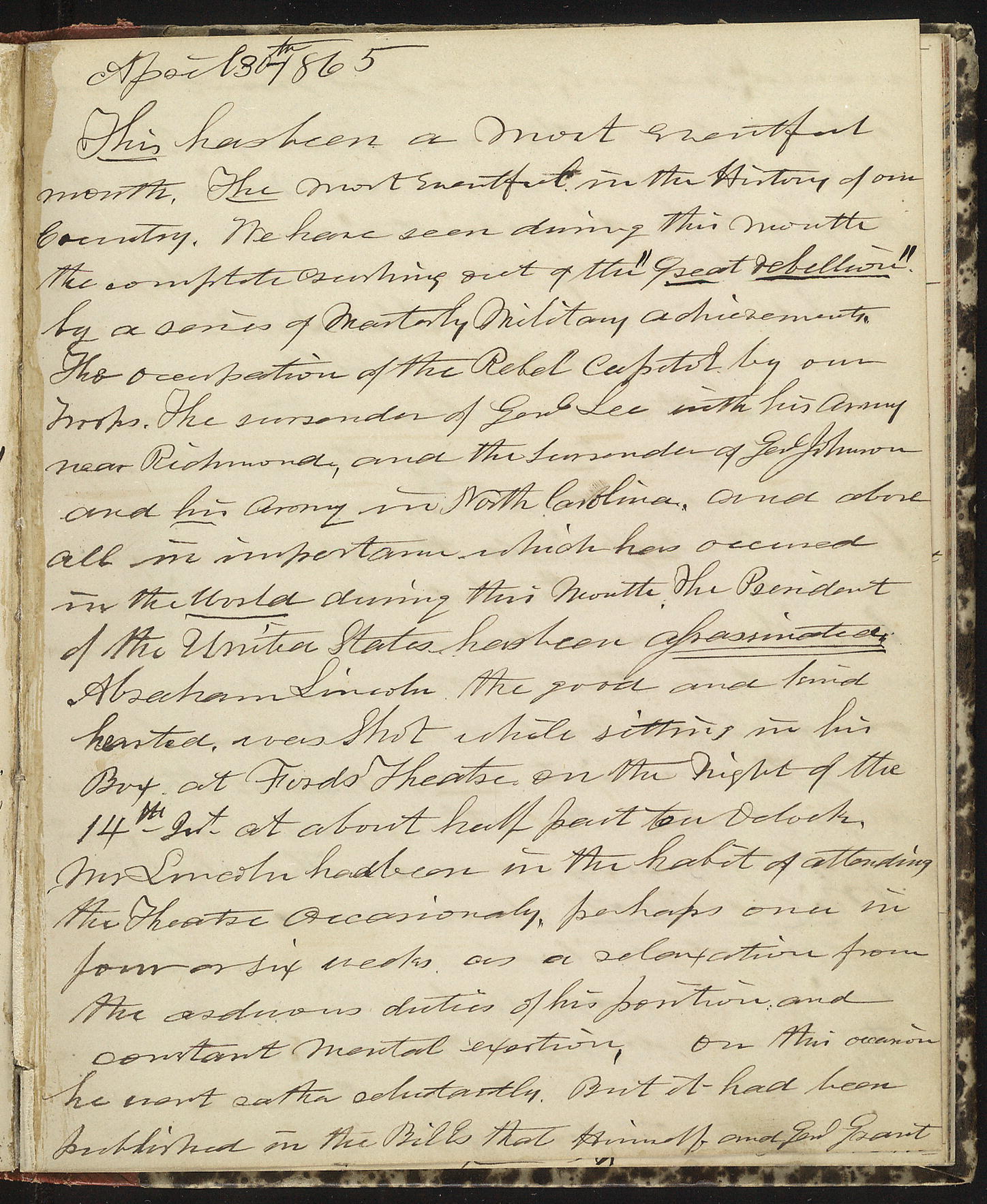
-
Description
Patent examiner Horatio Nelson Taft discussed the events of the previous month, calling April 1865 "the most eventful in the History of our Country."
-
Source
-
Rights
This item is in the public domain and may be reproduced and used for any purpose, including research, teaching, private study, publication, broadcast or commercial use, with proper citation and attribution.
-
Creator
Horatio Nelson Taft
-
Date
April 30, 1865
from Apr. 15, 1865
[Chattanooga Daily] Gazette Extra, April 15, [1865]
-
Full Title
[Chattanooga Daily] Gazette Extra, April 15, [1865]
-
Description
Broadside extra of Union-occupation newspaper providing details of the assassination of President Abraham Lincoln and the attempted assassination of Secretary William Henry Seward. Included are dispatches from Secretary of War Edwin M. Stanton to Major General John A. Dix, and a 2:00 pm report on the swearing-in of Andrew Johnson. Known as "mourning rules," the wide vertical lines between the newspaper columns represent grief over the loss of an important person.
-
Source
HN-1865-012220
-
Rights
Use of this item for research, teaching, and private study is permitted with proper citation and attribution as follows: Courtesy, Newseum Collection. Reproduction of this item for publication, broadcast, or commercial use requires written permission. For permission, please contact the Newseum.
-
Tags
-
Cite this Item
James R. Hood. "[Chattanooga Daily] Gazette Extra, April 15, [1865]". James R. Hood. Remembering Lincoln. Web. Accessed June 23, 2025. https://rememberinglincoln.fords.org/node/672
from Apr. 15, 1865
[Chattanooga Daily] Gazette Extra, April 15, [1865]
![[Chattanooga Daily] Gazette Extra, April 15, [1865]](https://rememberinglincoln.fords.org/sites/default/files/HN-1865-012220_wm.jpg)
-
Description
Broadside extra of Union-occupation newspaper providing details of the assassination of President Abraham Lincoln and the attempted assassination of Secretary William Henry Seward. Included are dispatches from Secretary of War Edwin M. Stanton to Major General John A. Dix, and a 2:00 pm report on the swearing-in of Andrew Johnson. Known as "mourning rules," the wide vertical lines between the newspaper columns represent grief over the loss of an important person.
-
Source
HN-1865-012220
-
Rights
Use of this item for research, teaching, and private study is permitted with proper citation and attribution as follows: Courtesy, Newseum Collection. Reproduction of this item for publication, broadcast, or commercial use requires written permission. For permission, please contact the Newseum.
-
Creator
James R. Hood
-
Publisher
James R. Hood
-
Date
April 15, 1865
-
Material
Newspaper
from Apr. 17, 1865
The Morning Bulletin, April 17, [1865]
-
Full Title
The Morning Bulletin, April 17, [1865]
-
Description
The front page of this Union-occupation newspaper from Memphis, Tennessee provides details of the assassination of President Abraham Lincoln and the attempted assassination of Secretary William Henry Seward. Included are dispatches from Secretary of War Edwin M. Stanton to Major General John A. Dix. Additional articles report falsely on the death of Seward and the capture of John Wilkes Booth. Further reports detail Andrew Johnson‰Ûªs inauguration, the murder of an Illinois copperhead for rejoicing in Lincoln‰Ûªs assassination, the speeches of Maj. Gen. N.P. Banks and Lieut. Governor of Illinois William Bross, the search for the assassins, and a report that John Surratt is the suspected attacker of Seward. In the far right column is an editor bulletin. Known as "mourning rules," the wide vertical lines between the newspaper columns represent grief over the loss of an important person.
-
Source
HN-1865-011090
-
Rights
Use of this item for research, teaching, and private study is permitted with proper citation and attribution as follows: Courtesy, Newseum Collection. Reproduction of this item for publication, broadcast, or commercial use requires written permission. For permission, please contact the Newseum.
-
Tags
-
Cite this Item
James B. Bingham. "The Morning Bulletin, April 17, [1865]". James B. Bingham. Remembering Lincoln. Web. Accessed June 23, 2025. https://rememberinglincoln.fords.org/node/673
from Apr. 17, 1865
The Morning Bulletin, April 17, [1865]
![The Morning Bulletin, April 17, [1865]](https://rememberinglincoln.fords.org/sites/default/files/HN-1865-011090_wm.jpg)
-
Description
The front page of this Union-occupation newspaper from Memphis, Tennessee provides details of the assassination of President Abraham Lincoln and the attempted assassination of Secretary William Henry Seward. Included are dispatches from Secretary of War Edwin M. Stanton to Major General John A. Dix. Additional articles report falsely on the death of Seward and the capture of John Wilkes Booth. Further reports detail Andrew Johnson‰Ûªs inauguration, the murder of an Illinois copperhead for rejoicing in Lincoln‰Ûªs assassination, the speeches of Maj. Gen. N.P. Banks and Lieut. Governor of Illinois William Bross, the search for the assassins, and a report that John Surratt is the suspected attacker of Seward. In the far right column is an editor bulletin. Known as "mourning rules," the wide vertical lines between the newspaper columns represent grief over the loss of an important person.
-
Source
HN-1865-011090
-
Rights
Use of this item for research, teaching, and private study is permitted with proper citation and attribution as follows: Courtesy, Newseum Collection. Reproduction of this item for publication, broadcast, or commercial use requires written permission. For permission, please contact the Newseum.
-
Creator
James B. Bingham
-
Publisher
James B. Bingham
-
Date
April 17, 1865
-
Material
Newspaper
from Apr. 17, 1865
C. Wallach to S.S. Ward, Jr., April 17, 1865
-
Full Title
Letter signed C. Wallach, Paymaster U.S. Navy, Paymaster's Office, U.S. Naval Station, New Berne, N.C., to Paymaster S.S. Ward jr., U.S. Naval Station, Fort Macon, April 17, 1865
-
Description
States, "Can you send me 500 pair Satinet Trousers over the road? if not send by 'Culpepper.' Do not ship anything North, until you hear from me. I will send you a list of Stores wanted here. President Lincoln was murdered in Ford's Theatre Washington at 10 P.M. on the 14th. This is official. . . ."
-
Rights
This item is in the public domain.
-
Tags
-
Cite this Item
Wallach, C.. "Letter signed C. Wallach, Paymaster U.S. Navy, Paymaster's Office, U.S. Naval Station, New Berne, N.C., to Paymaster S.S. Ward jr., U.S. Naval Station, Fort Macon, April 17, 1865". . Remembering Lincoln. Web. Accessed June 23, 2025. https://rememberinglincoln.fords.org/node/643
from Apr. 17, 1865
Letter signed C. Wallach, Paymaster U.S. Navy, Paymaster's Office, U.S. Naval Station, New Berne, N.C., to Paymaster S.S. Ward jr., U.S. Naval Station, Fort Macon, April 17, 1865
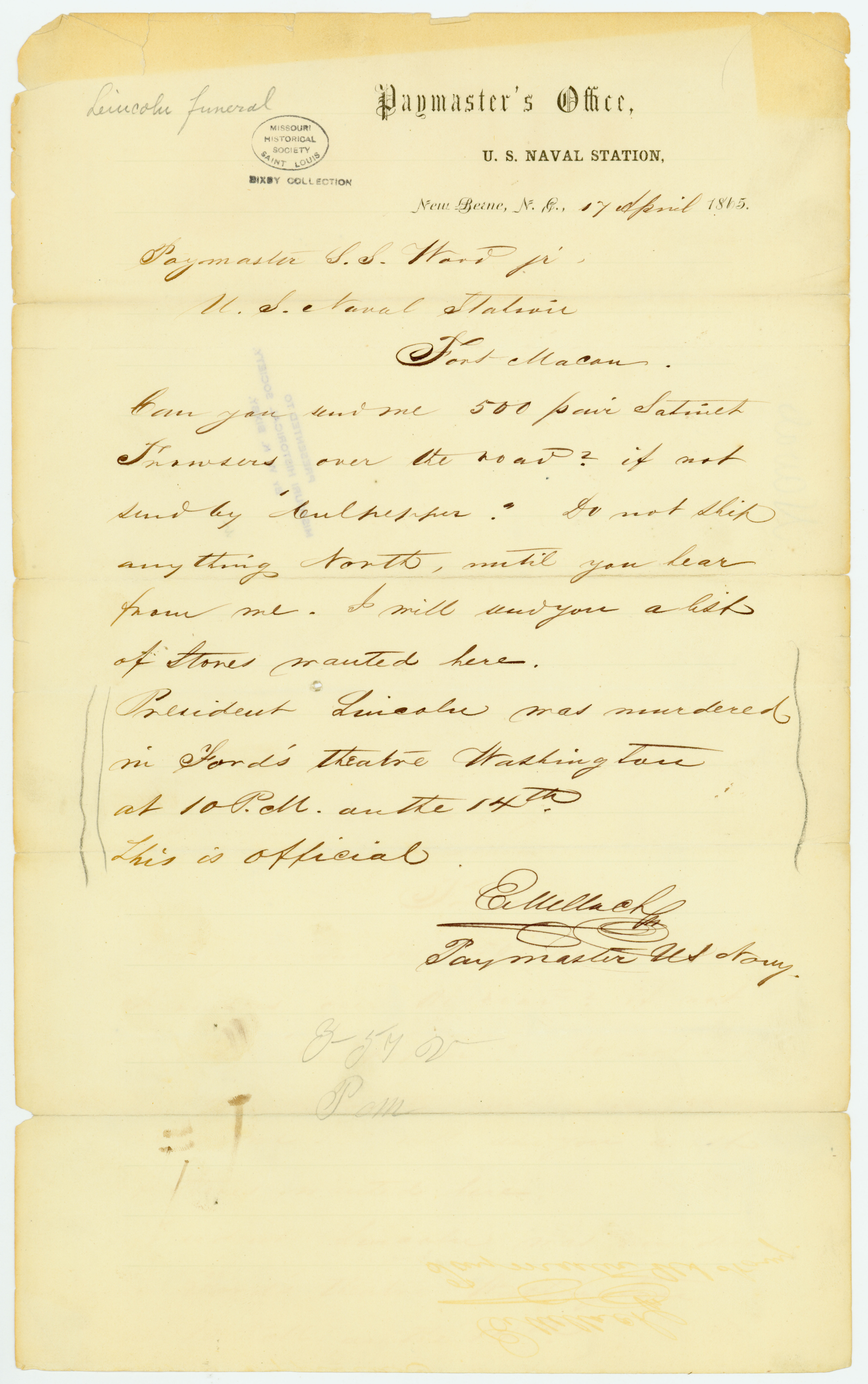
-
Description
States, "Can you send me 500 pair Satinet Trousers over the road? if not send by 'Culpepper.' Do not ship anything North, until you hear from me. I will send you a list of Stores wanted here. President Lincoln was murdered in Ford's Theatre Washington at 10 P.M. on the 14th. This is official. . . ."
-
Rights
This item is in the public domain.
-
Creator
Wallach, C.
-
Publisher
-
Date
April 17, 1865
-
Material
from Apr. 21, 1865
The Liberator, April 21, 1865
-
Full Title
The Liberator, April 21, 1865
-
Description
William Lloyd Garrison's abolitionist newspaper provides extensive details on the assassination of President Abraham Lincoln and the attempted assassination of Secretary William Henry Seward. It contains the 1:30 a.m. official dispatch from Secretary of War Edwin M. Stanton to Major General John A. Dix, as well as the 8:00 a.m. dispatch reporting Lincoln's death. Known as "mourning rules," the wide vertical lines between the newspaper columns represent grief over the loss of an important person.
-
Source
HN-1865-011108B
-
Rights
Use of this item for research, teaching, and private study is permitted with proper citation and attribution as follows: Courtesy, Newseum Collection. Reproduction of this item for publication, broadcast, or commercial use requires written permission. For permission, please contact us at artifacts@newseum.org.
-
Tags
-
Cite this Item
Wm. Lloyd Garrison. "The Liberator, April 21, 1865". Wm. Lloyd Garrison. Remembering Lincoln. Web. Accessed June 23, 2025. https://rememberinglincoln.fords.org/node/630
from Apr. 21, 1865
The Liberator, April 21, 1865

-
Description
William Lloyd Garrison's abolitionist newspaper provides extensive details on the assassination of President Abraham Lincoln and the attempted assassination of Secretary William Henry Seward. It contains the 1:30 a.m. official dispatch from Secretary of War Edwin M. Stanton to Major General John A. Dix, as well as the 8:00 a.m. dispatch reporting Lincoln's death. Known as "mourning rules," the wide vertical lines between the newspaper columns represent grief over the loss of an important person.
-
Source
HN-1865-011108B
-
Rights
Use of this item for research, teaching, and private study is permitted with proper citation and attribution as follows: Courtesy, Newseum Collection. Reproduction of this item for publication, broadcast, or commercial use requires written permission. For permission, please contact us at artifacts@newseum.org.
-
Creator
Wm. Lloyd Garrison
-
Publisher
Wm. Lloyd Garrison
-
Date
April 21, 1865
-
Material
Newspaper
from Apr. 20, 1865
The Weekly Reporter, April 20, 1865
-
Full Title
The Weekly Reporter, April 20, 1865
-
Description
Front page report providing extensive details on the assassination of President Abraham Lincoln and the attempted assassination of Secretary William H. Seward. The newspaper contains the official 1:30 a.m. and 4:10 a.m. dispatches from Secretary of War Edwin M. Stanton to Major General John A. Dix, as well as the 7:22 a.m. report of Lincoln's death. Known as "mourning rules," the wide vertical lines between the newspaper columns represent grief over the loss of an important person.
-
Source
HN-1865-011104
-
Rights
Use of this item for research, teaching, and private study is permitted with proper citation and attribution as follows: Courtesy, Newseum Collection. Reproduction of this item for publication, broadcast, or commercial use requires written permission. For permission, please contact the Newseum.
-
Tags
-
Cite this Item
Spidel & Staples. "The Weekly Reporter, April 20, 1865". Spidel & Staples. Remembering Lincoln. Web. Accessed June 23, 2025. https://rememberinglincoln.fords.org/node/628
from Apr. 20, 1865
The Weekly Reporter, April 20, 1865
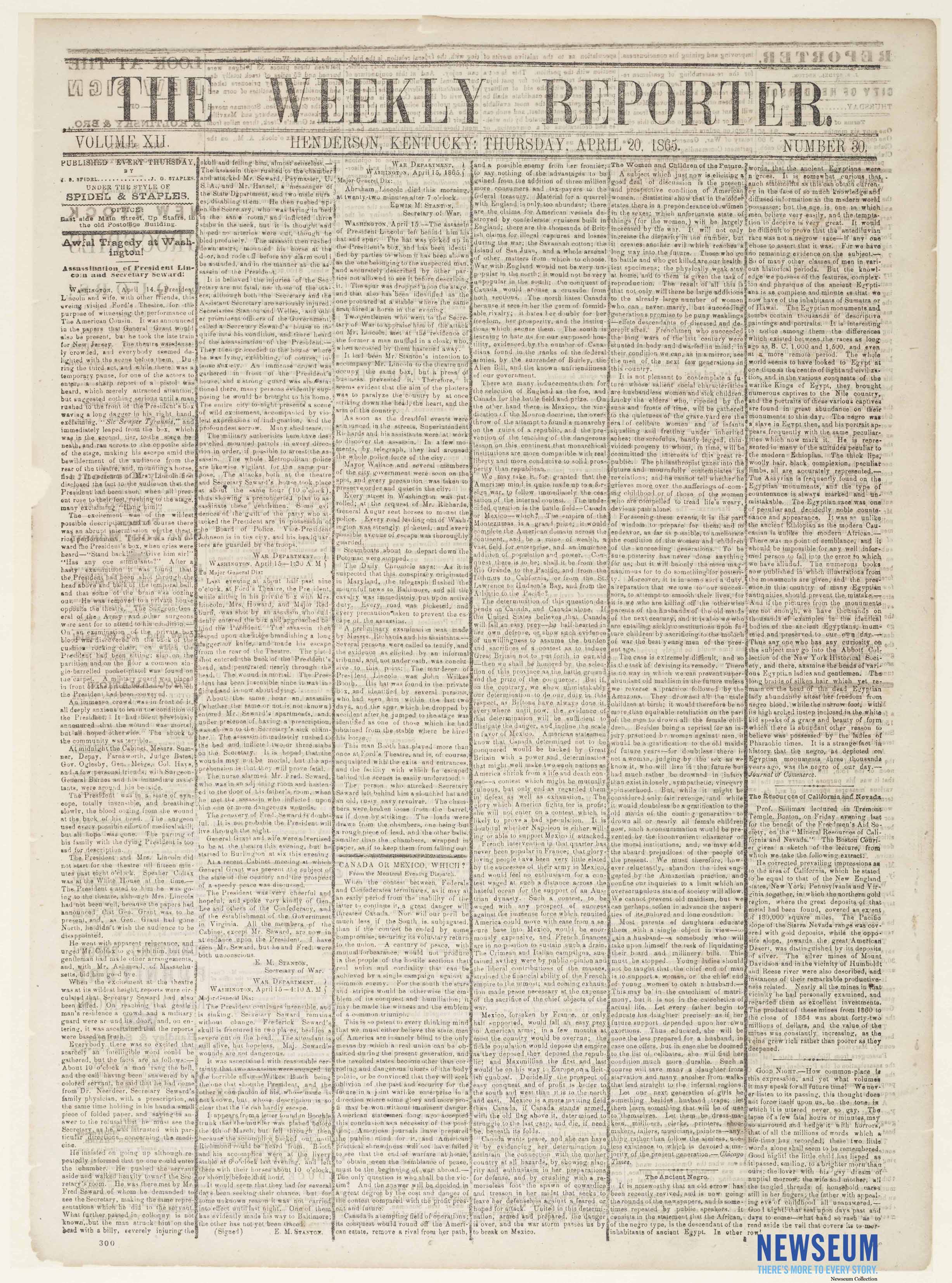
-
Description
Front page report providing extensive details on the assassination of President Abraham Lincoln and the attempted assassination of Secretary William H. Seward. The newspaper contains the official 1:30 a.m. and 4:10 a.m. dispatches from Secretary of War Edwin M. Stanton to Major General John A. Dix, as well as the 7:22 a.m. report of Lincoln's death. Known as "mourning rules," the wide vertical lines between the newspaper columns represent grief over the loss of an important person.
-
Source
HN-1865-011104
-
Rights
Use of this item for research, teaching, and private study is permitted with proper citation and attribution as follows: Courtesy, Newseum Collection. Reproduction of this item for publication, broadcast, or commercial use requires written permission. For permission, please contact the Newseum.
-
Creator
Spidel & Staples
-
Publisher
Spidel & Staples
-
Date
April 20, 1865
-
Material
Newspaper
from Apr. 15, 1865
Illinois Daily State Journal, April 15, 1865
-
Full Title
Illinois Daily State Journal, April 15, 1865
-
Description
Interior page report in the Illinois Daily State Journal providing details on the assassination of President Abraham Lincoln and the attempted assassination of Secretary William Henry Seward. The article contains a 1:30 a.m. official dispatch from Secretary of War Edwin M. Stanton to Major General John A. Dix advising him of the attack. Known as "mourning rules," the wide vertical lines between the newspaper columns represent grief over the loss of an important person.
-
Source
HN-1865-011062B
-
Rights
Use of this item for research, teaching, and private study is permitted with proper citation and attribution as follows: Courtesy, Newseum Collection. Reproduction of this item for publication, broadcast, or commercial use requires written permission. For permission, please contact the Newseum.
-
Tags
-
Cite this Item
Baker & Phillips. "Illinois Daily State Journal, April 15, 1865". Baker & Phillips. Remembering Lincoln. Web. Accessed June 23, 2025. https://rememberinglincoln.fords.org/node/624
from Apr. 15, 1865
Illinois Daily State Journal, April 15, 1865
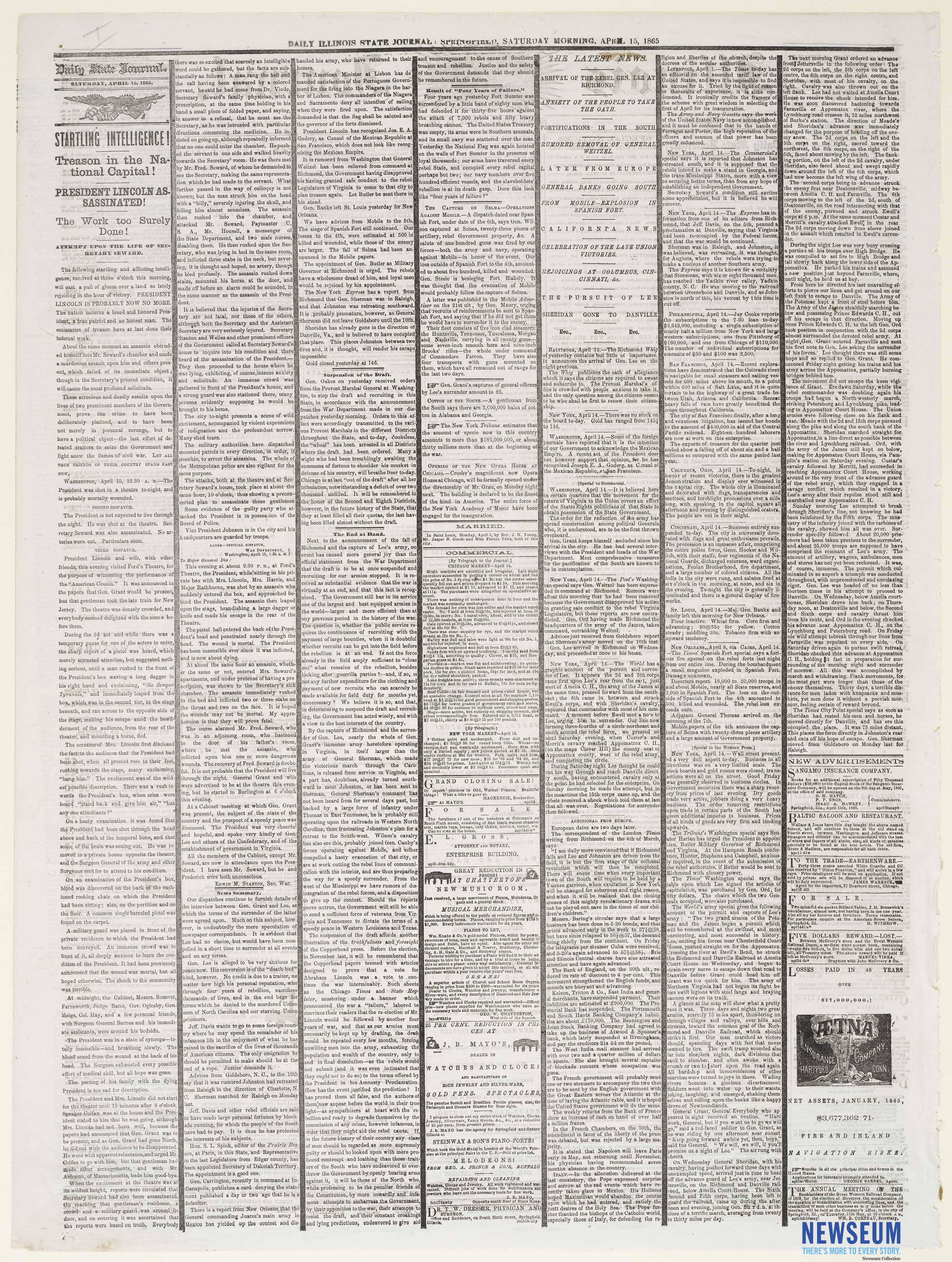
-
Description
Interior page report in the Illinois Daily State Journal providing details on the assassination of President Abraham Lincoln and the attempted assassination of Secretary William Henry Seward. The article contains a 1:30 a.m. official dispatch from Secretary of War Edwin M. Stanton to Major General John A. Dix advising him of the attack. Known as "mourning rules," the wide vertical lines between the newspaper columns represent grief over the loss of an important person.
-
Source
HN-1865-011062B
-
Rights
Use of this item for research, teaching, and private study is permitted with proper citation and attribution as follows: Courtesy, Newseum Collection. Reproduction of this item for publication, broadcast, or commercial use requires written permission. For permission, please contact the Newseum.
-
Creator
Baker & Phillips
-
Publisher
Baker & Phillips
-
Date
April 15, 1865
-
Material
Newspaper

